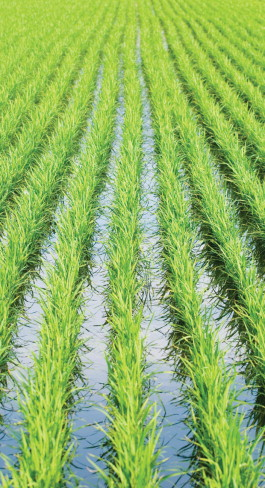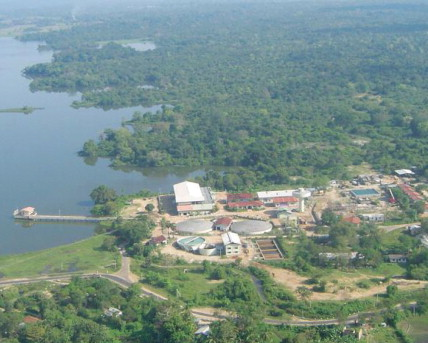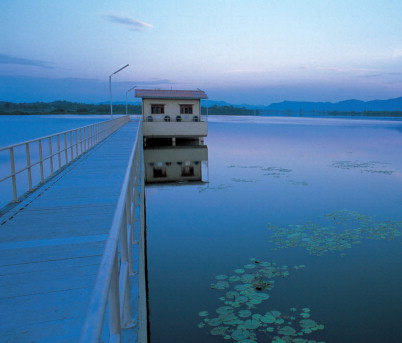


A pdf version of this article is available on the right-hand side under 'Downloads'
The Sri Lankan project, built between 1999-2007 in the Ampara district, 350km from the capital Colombo, is comfortably coping with harsh local conditions, including unreliable power supply, limited maintenance, large seasonal raw water quality variations and fluctuations in demand.
“After more than two years from Phase II commissioning, the treatment plant is continuing to provide good quality water to consumers, within design targets, 24/7,” said Outotec project director Steve Giffin, based in Sri Lanka.
Following the success of this project, the Sri Lankan National Water Supply and Drainage Board (NWS&DB) now plans to follow it with another covering a further 350,000 people.
The Ampara district on the east coast of Sri Lanka is one of the least developed areas in the country, being semi-rural, affected by civil war and disturbance, with the completion of large-scale projects presenting a significant challenge. In 1997, Sri Lanka's NWS&DB launched a programme to provide a large population of previously unserved communities with quality piped drinking water under the ECTAD (Eastern Coastal Towns of Ampara District) project. Outotec was awarded the initial and subsequent phase of this project, carried out from 1999 to 2007. As the complete turnkey supplier, Outotec was tasked with the design, construction and commissioning of a water supply scheme, which was to provide piped water to 300,000 people in the Ampara District for the first time.
The NWS&DB is the principal government authority for the nation of Sri Lanka responsible for providing safe drinking water and sanitation for the population. A workforce of about 8,000 is employed nationwide.
Drinking water situation
The Ampara district is on the east coast of Sri Lanka, population circa 611,000, with a tropical climate and a long dry season. The district is rural and primarily agricultural, relying on a large irrigation network of reservoirs and canals for rice paddy farming. However, there are water quality and scarcity issues with the traditional water sources due to intensive farming and resultant fertilizer, soil and chemical run-off. In the densely populated coastal towns, limited land availability has resulted in some septic sanitation systems being installed very close to drinking water wells, with contamination common. With a growing population, the need for pipe borne safe water was never greater in Ampara.
Outotec says that the project structure was turnkey ‘catchment to consumer', meaning that all design, construction and commissioning from the raw water reservoir all the way to the distribution networks at town street level, was under the its direct responsibility. Outotec was the head contractor, working closely with process designers and equipment suppliers, and hand-in-hand with local Sri Lankan partners.
The combined Phase I and II project scope included raw water intake structure, a 15.86 MGD (72 ML/day) DAF filtration treatment plant including all chemical dosing and residuals handling, clearwater storage, transmission mains, five booster pump stations each with 1600 m3 capacity, nine elevated storage towers of 1125 m3 or 1600 m3 capacity, and nine distribution networks, covering a total project area of approximately 500 km2.
Remote location
The Ampara District location, 350 km from the capital Colombo, created difficulties. An undeveloped region, poor in infrastructure, with limited available technology and little local skilled/semi-skilled labour, the region's recent history of civil unrest and difficulty in attracting outside contractors had its own unique set of challenges, requiring patience, flexibility and strong management. The outcomes of the ECTAD projects show that Outotec was successful in dealing with these barriers.
According to the company, project management was an extremely complex task due to the magnitude of the project, interaction between the various cultures on the job, language barriers and geographic distance between involved parties. Mechanical and process design was carried out in Australia, civil and electrical design and detailing in Sri Lanka, with significant participation from NSW&DB. An office of expat and local personnel was established in Sri Lanka to manage the various project phases, providing project management, drafting and engineering personnel. Equipment was sourced from vendors in Asia, Europe, USA and Australia. At its peak, up to 1200 workers were involved in the construction process across as many as 20 sites. The project was completed in a timeframe seldom achieved in Sri Lanka.
Outotec says that the installation included a number of ‘technological firsts' in Sri Lanka. Dissolves air flotation (DAF) was used for water pretreatment before filtration. DAF is favoured for algae affected waters, replacing conventional sedimentation. In addition, there are powdered activated carbon (PAC) systems to combat taste and odour – to remove seasonal non-toxic algal taste and odour compounds, as well as adsorption of potential algal toxins. Decanter centrifuges for thickener sludge dewatering were included to produce a solid transportable cake for offsite disposal. The system also included a self-lift slip formwork for tower shaft construction to improve quality, safety and reduce construction times, compared to scaffolding and external crane methods. Other installations in Sri Lanka have now begun to adopt some of the same solutions.
The full treatment process involved raw water fed to the treatment plant where it is extracted from an irrigation reservoir. The treatment process involves pre-chlorination, followed by coagulant addition, taste and odour control, flash mixing, mechanical flocculation, dissolved air flotation (DAF) over monomedia sand filters, post-chlorine disinfection, lime pH correction and clearwater storage. Plant residuals handling comprises of thickening with flocculant dosing, thickener sludge storage, and decanter centrifugation.
Maintaining quality in such a remote area was given high priority by the NSW&DB and Outotec. Design choices, construction methods and material selections were determined with quality, reliability and robust performance in mind.
An unintended quality test occurred as a result of the 2004 tsunami. The main wave struck the under construction Phase II Marathamunai water tower, with the resulting water mark reaching 6 metres up the shaft. The tower was undamaged while the surrounding area was devastated. The tsunami affected the district heavily in terms of loss of life and polluted the previously viable water sources with saline water and septic contaminants. Thus, it became increasingly important to complete the Phase II project as quickly as possible to expand water supply to tsunami-affected towns. Phase I continued to provide safe water to the affected areas and reliable, clean water was one of the key reasons there was no outbreak of disease in the aftermath.
After more than two years from Phase II commissioning, the treatment plant is still providing good quality water to consumers, within the design targets. The system is comfortably coping with the harsh local conditions, including unreliable power supply, limited maintenance, large seasonal raw water quality variations and fluctuations in demand.
With ECTAD Phase I and II successfully completed by Outotec, a further project expansion is planned by NSW&DB. This expansion will cover up to 350,000 people in the inland unserved areas of the Ampara District, bringing the total coverage of the district to 611,000 people by 2020. Completion of the extension would make the overall ECTAD scheme one of the largest rural water supply schemes in Sri Lanka.






